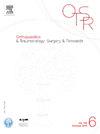Double-level osteotomy for varus knees using patient-specific cutting guides allow more accurate correction but similar clinical outcomes as compared to conventional techniques
IF 2.3
3区 医学
Q2 ORTHOPEDICS
引用次数: 0
Abstract
Purpose
Patient-specific cutting guides are increasingly used in the field of osteotomies around the knee and can improve the accuracy of planned correction and more specifically in the case of double-level osteotomy (DLO). The purpose of this study was to analyse the accuracy of postoperative coronal alignment after DLO using patient-specific cutting guides techniques (PSI) compared to conventional techniques.
The secondary objective was to compare the functional results between the two groups at short-term follow-up.
Hypothesis
The accuracy of global correction (HKA angle) is better with patient-specific cutting guides compared to conventional techniques for double-level osteotomy
Methods
This multicentric comparative retrospective study included 53 patients (mean age: 53.8 ± 5.2 years, male/female: 44/9) who underwent a DLO for knee varus malalignment. The coronal correction accuracy (as expressed by the difference between postoperative angular values and preoperative targeted correction) was compared between techniques using patient-specific cutting guides (PSI group, n = 27) or conventional techniques (n = 26) for the medial proximal tibial angle (MPTA) and the lateral distal femoral angle (LDFA). Postoperatively, the global alignment expressed by the hip-knee-ankle angle and the joint line obliquity were compared between groups. The postoperative functional results for KOOS and UCLA activity scale score were also compared at a mean follow-up of 1.7 years (1.0–3.1 years).
Results
No difference was observed for the postoperative global alignment between the PSI and the conventional groups (Δ = 0.6 °, p = 0.11) neither for the postoperative posterior proximal tibial angle (Δ = 1.6°, p = 0,99) or the joint line obliquity (Δ = 0.3°, p = 0,17). In the coronal plane, the postoperative MPTA was lower in the PSI group (Δ = 2.3°, p < 0.001) as well as the postoperative LDFA (Δ = 0.9°, p = 0.01).
Concerning correction accuracy in the coronal plane, the results showed a significant higher accuracy of the planned correction in the PSI group compared to the conventional group for MPTA (2.2 ± 0.2 versus 0.8 ± 0.7, Δ = 1.5 °, p < 0.001) and LDFA (1.3 ± 1.0 versus 0.6 ± 0.9, Δ = 0.7°, p < 0.001).
No improvement difference was observed between the conventional group and the PSI group respectively for the KOOS symptoms (p = 0.12), the KOOS Pain (p = 0,57), the KOOS activities of daily living (p = 0.61), the KOOS sport/rec (p = 0.65), or for the KOOS Quality of Life (p = 0.99) neither for the UCLA (p = 0.97).
Conclusions
This study suggests that the use of custom-made cutting guides improves the accuracy of planned correction in double-level osteotomy compared with conventional techniques, which may have implications particularly in centers not performing a large volume of osteotomies.
This improved accuracy is not associated with any difference in joint line obliquity or functional results but these results need to be confirmed by a randomized prospective study.
Level of evidence
: III; Retrospective comparative study
与传统技术相比,使用患者特异性切割导板对膝关节外翻进行双层截骨术可实现更精确的矫正,但临床效果相似。
目的:患者特异性切割导板在膝关节周围截骨领域的应用越来越广泛,它可以提高计划矫正的准确性,尤其是在双层截骨术(DLO)中。本研究的目的是分析使用患者特异性切割导板技术(PSI)与传统技术相比,DLO术后冠状对位的准确性。次要目的是比较两组患者在短期随访中的功能结果:方法:这项多中心回顾性比较研究纳入了 53 名因膝关节屈曲不正接受 DLO 的患者(平均年龄:53.8 ± 5.2 岁,男性/女性:44/9)。在胫骨内侧近端角度(MPTA)和股骨外侧远端角度(LDFA)方面,比较了患者特异性切削导板技术(PSI 组,n = 27)和传统技术(n = 26)的冠状位矫正准确性(以术后角度值和术前目标矫正值之间的差异表示)。术后,通过髋关节-膝关节-踝关节角度和关节线斜度来比较各组间的整体对位情况。此外,还比较了平均随访 1.7 年(1.0-3.1 年)的 KOOS 和 UCLA 活动量表评分的术后功能结果:结果:PSI 组和传统组的术后整体对线(Δ = 0.6°,p = 0.11)和术后胫骨后近端角度(Δ = 1.6°,p = 0.99)或关节线斜度(Δ = 0.3°,p = 0.17)均无差异。在冠状面上,PSI 组术后 MPTA 更低(Δ = 2.3°,p 结论:PSI 组术后 MPTA 更低(Δ = 1.6°,p = 0.99):这项研究表明,与传统技术相比,使用定制的切割导板可提高双层截骨术中计划矫正的准确性,这对不进行大量截骨手术的中心可能具有重要意义。这种准确性的提高与关节线斜度或功能结果的差异无关,但这些结果需要通过随机前瞻性研究来证实:证据等级:III;回顾性比较研究。
本文章由计算机程序翻译,如有差异,请以英文原文为准。
求助全文
约1分钟内获得全文
求助全文
来源期刊
CiteScore
5.10
自引率
26.10%
发文量
329
审稿时长
12.5 weeks
期刊介绍:
Orthopaedics & Traumatology: Surgery & Research (OTSR) publishes original scientific work in English related to all domains of orthopaedics. Original articles, Reviews, Technical notes and Concise follow-up of a former OTSR study are published in English in electronic form only and indexed in the main international databases.

 求助内容:
求助内容: 应助结果提醒方式:
应助结果提醒方式:


